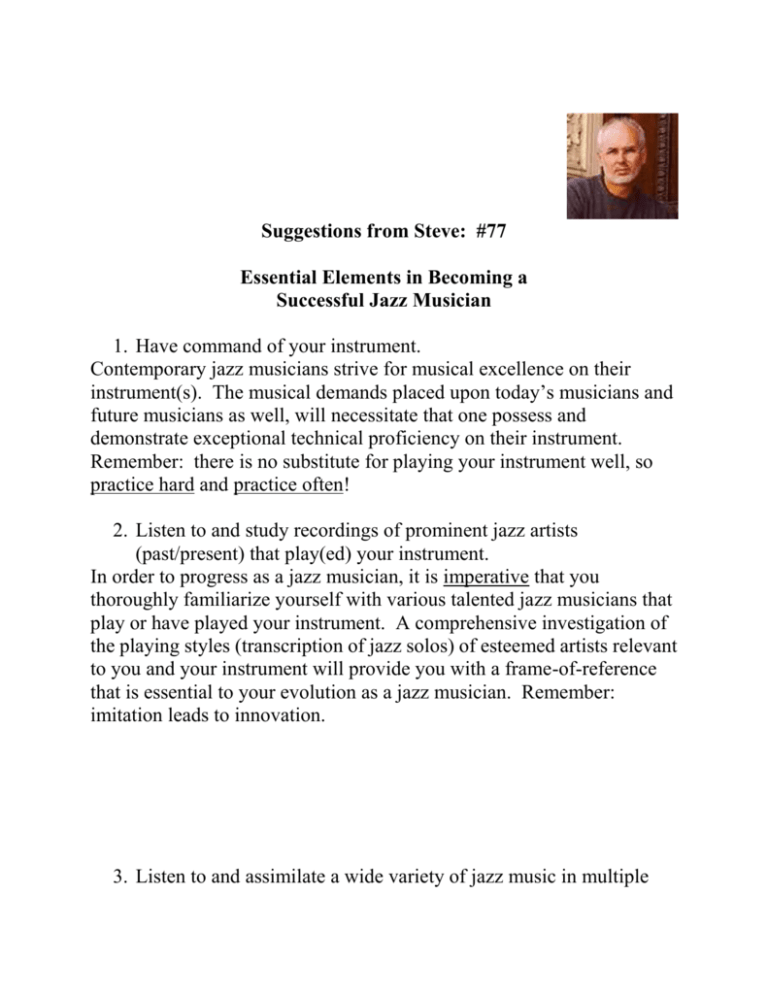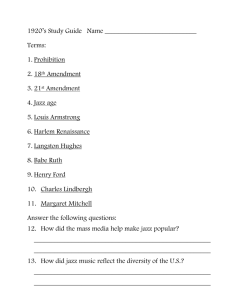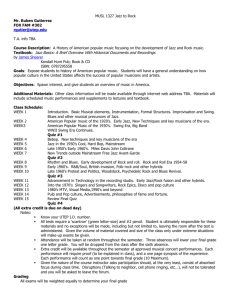
Suggestions from Steve: #77
Essential Elements in Becoming a
Successful Jazz Musician
1. Have command of your instrument.
Contemporary jazz musicians strive for musical excellence on their
instrument(s). The musical demands placed upon today’s musicians and
future musicians as well, will necessitate that one possess and
demonstrate exceptional technical proficiency on their instrument.
Remember: there is no substitute for playing your instrument well, so
practice hard and practice often!
2. Listen to and study recordings of prominent jazz artists
(past/present) that play(ed) your instrument.
In order to progress as a jazz musician, it is imperative that you
thoroughly familiarize yourself with various talented jazz musicians that
play or have played your instrument. A comprehensive investigation of
the playing styles (transcription of jazz solos) of esteemed artists relevant
to you and your instrument will provide you with a frame-of-reference
that is essential to your evolution as a jazz musician. Remember:
imitation leads to innovation.
3. Listen to and assimilate a wide variety of jazz music in multiple
styles throughout the evolution of jazz.
Contemporary jazz musicians are expected to assimilate and demonstrate
historically accurate playing styles on their instrument(s), which are
defined by the diversity within the jazz idiom's musical repertoire. This
requires all 'serious-minded' musicians become competent playing swing;
latin; funk/R&B; fusion; third stream; world; etc., in a variety of styles
and contexts. An extensive amount of listening, study and finally,
application of these musical styles is a necessity for all professional jazz
musicians.
4. Study and apply the principles of jazz theory and harmony within an
improvisational context (ensemble).
One of the primary components of jazz music is improvisation,
sometimes referred to as “spontaneous composition.” Jazz improvisation
is the process whereby an instrumentalist or vocalist instantaneously and
creatively manipulates the elements of music such as melody, harmony
and rhythm within a specific jazz musical format. In order to do this
competently in contemporary times, one generally needs to first study
jazz theory and harmony with an insightful jazz instructor
(player/educator). Then, as the individual develops a deeper
understanding of these concepts, he/she can then begin to apply these
principles and begin improvising and creating their own ideas on their
instrument. Learning to improvise is a compelling and demanding
process that requires time, patience and thoughtfulness by the player. I
recommend using instructional texts by authors such as Jamey Abersold
and many others to assist you in your improvisational endeavors.
5. Participate in impromptu jazz “jam sessions.”
One of the most rewarding experiences any ‘jazzer’ can have is to play
their instrument in a 'jam session.' Jam sessions are informal musical
gatherings of jazz-inspired individuals that want to work on their
improvising. These casual get-togethers afford musicians the opportunity
to interact creatively with others within an ensemble setting. Learning
how to play jazz music with other musicians is something that must be
experienced, not just studied.
6. Learn how your instrument functions within jazz groups.
In order to become a valuable contributing member to a jazz band(s), you
really need to understand what role(s) your instrument plays within the
ensemble. For instance, if you are a pianist, how well do you understand
and execute the “art of accompaniment” (a/k/a; comping) in a variety of
styles within the band? If you are a bassist, how well do you create and
play “walking bass lines” in jazz-swing style? If you are a drummer, how
well do you "keep time" and can you authentically play grooves in
multiple musical styles (latin music represents quite a challenge by
itself)? How do/should the piano, bass and drums interact with one
another on any given jazz chart in a combo or big band format? In
summation: instrumentalists have to develop their own skills in order to
then be able to ‘communicate’ effectively and correctly with the other
instruments of the jazz band.
7. Become knowledgeable with the jazz vocabulary.
Do you know what fills and kicks are? How about trading 4’s and 8’s?
Does sax soli mean anything to you? Do you know all the jazz
articulations and what they mean? How about a ‘shout’ chorus or brass
punches? How about cha-cha-cha versus a bossa nova? What is a
montuno and how is it designed? How many measures are there in ‘two’
choruses of the blues? What is a cadenza and stop-time rhythm?
What are 'rhythm changes'? What is a ‘vamp’ and what does ‘on cue’
refer to? Have you ever heard of vocables, ‘blue’ notes, chord extensions
and color tones? If any of these techniques, concepts or musical styles is
unfamiliar to you, it’s time to learn more about the language of jazz
music. When you make a commitment to learning how to play jazz, you
need to address the many components that are utilized within the musical
genre.
8. Sightreading skills are of critical importance to the jazz musician.
Because jazz music is so multi-faceted and challenging, possessing the
requisite skill of sightreading is essential to one’s success as a performing
musician. Jazz musicians are often expected to sightread and interpret
numerous charts (big band or combo) during a standard rehearsal. If you
are unable to sightread the music given to you by jazz band directors;
music employers; band leaders’; etc., you may not be accepted into the
ensemble or may not be hired as a professional musician. Competent
‘jazzers’ sightread complex rhythms and melodies with relative ease.
Moreover, they interpret the sightreading material with a great deal of
musical insight and intuition. Sightreading is a skill much like many
other skills that takes time to develop. Therefore, work on your
sightreading and broaden your scope and potential as a jazz musician.
9. Swing is king.
If you want to be considered a skilled jazz musician, you must be able to
play big band and combo charts in jazz-swing style. Swing music is at the
very heart-center of jazz--America’s great musical creation that
revolutionized music throughout the world. As I mentioned earlier in #3,
jazz musicians are expected to play a variety of musical styles on their
instruments, but as it has been said before, “It don’t mean a thing, if it
ain’t got that swing.”
Swing music has evolved since its inception, which means that
contemporary jazz musicians need to possess an historical understanding
of how to play swing (big-band style vs. bebop) with authenticity.
Studying the evolution of jazz-swing style as played by its premier
practitioners is important, but you must ultimately play the music in order
to feel the essence of a great swing groove and to realize why Swing
is....King.
10.Timekeeping tells all.
When all things are said and done, how well do you and the band play
time? How well are you and the ensemble locked into a solid groove?
Ultimately, if the music doesn’t feel good, (pertains to any style) it’s just
'not happening' as jazz players are quick to point out to the other band
members. Jazz musicians have a responsibility to themselves and to their
bandmates to establish and maintain a steady time feel within the band.
Practice with a metronome and remember that although the rhythm
section (piano; bass; drums; guitar; vibes and percussion) is expected to
shoulder the primary timekeeping duties, everyone in the band needs to be
accountable for keeping the time solid, steady and groovin’.
Copyright 2004 Steve Raybine
All Rights Reserved








